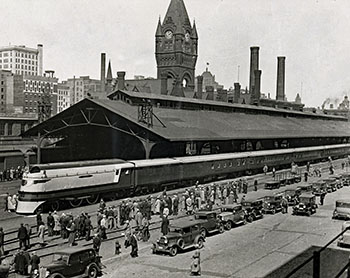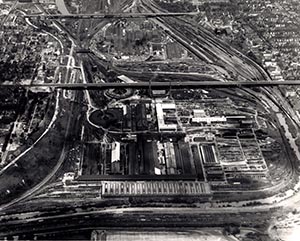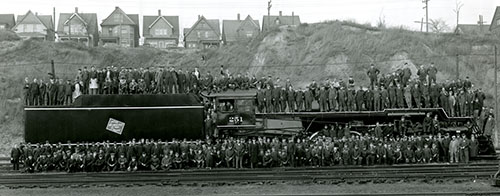Milwaukee Road: Rails of Innovation

 On November 1st the Milwaukee Road: Rails of Innovation exhibit opened. It will be available to browse through December 31. This exhibit celebrates one of America’s most transformative railroads, the Milwaukee Road. Officially known as the Chicago, Milwaukee, St. Paul & Pacific Railroad, it was a major American railroad that played a pivotal role in the development of Milwaukee and the Midwest. Established in 1847 as Wisconsin’s first railroad under the name Milwaukee and Waukesha Railroad, it connected Milwaukee to the Mississippi River by 1857.
On November 1st the Milwaukee Road: Rails of Innovation exhibit opened. It will be available to browse through December 31. This exhibit celebrates one of America’s most transformative railroads, the Milwaukee Road. Officially known as the Chicago, Milwaukee, St. Paul & Pacific Railroad, it was a major American railroad that played a pivotal role in the development of Milwaukee and the Midwest. Established in 1847 as Wisconsin’s first railroad under the name Milwaukee and Waukesha Railroad, it connected Milwaukee to the Mississippi River by 1857.
 On October 14, 1867, the Milwaukee Road established the first direct rail route between Chicago and the Twin Cities, a groundbreaking achievement made possible through the acquisition of several smaller railroads and rapid expansion. This “Pioneer Route” allowed passengers to travel directly between these major cities and later inspired the naming of the iconic "Pioneer Limited," one of the Milwaukee’s most significant passenger trains.
On October 14, 1867, the Milwaukee Road established the first direct rail route between Chicago and the Twin Cities, a groundbreaking achievement made possible through the acquisition of several smaller railroads and rapid expansion. This “Pioneer Route” allowed passengers to travel directly between these major cities and later inspired the naming of the iconic "Pioneer Limited," one of the Milwaukee’s most significant passenger trains.
Over the years, the railroad expanded rapidly throughout the Midwest, eventually reaching the Pacific coast in 1909. Throughout its history, the company acquired and merged with various other railroads, adopting the name Chicago, Milwaukee & St. Paul in February 1874, and finally becoming the Chicago, Milwaukee, St. Paul & Pacific Railroad in 1927.
 The Milwaukee Shops, the Milwaukee Road's manufacturing facility, once occupied 160 acres of land east of Milwaukee's baseball stadium. This expansive complex served as the nerve center of an 11,000-mile rail network, functioning as a foundry, machine shop, storehouse, research and development center, and a hub for repairs and manufacturing. Remarkable in its scale, the Milwaukee Shops were unique among railroads for their breadth of operations.
The Milwaukee Shops, the Milwaukee Road's manufacturing facility, once occupied 160 acres of land east of Milwaukee's baseball stadium. This expansive complex served as the nerve center of an 11,000-mile rail network, functioning as a foundry, machine shop, storehouse, research and development center, and a hub for repairs and manufacturing. Remarkable in its scale, the Milwaukee Shops were unique among railroads for their breadth of operations.

By 1937, the Milwaukee Shops boasted over 1,265,000 square feet of shop space and employed more than 2,800 people. The Shops built nearly 700 locomotives, completing one engine every three days at its peak. Between 1941 and 1950 alone, the Shops constructed over 20,000 freight cars, 165 cabooses, and 220 passenger cars. The Shops also required two roundhouses on site for locomotive maintenance, fitting nearly 80 locomotives at once. In the 1940s as many as 99 steam locomotives were serviced daily and eight could undergo heavy repairs or rebuilding.
 The electrification of the Milwaukee Road’s western lines stands as one of its most significant technological achievements. Faced with the challenge of operating steam locomotives over five mountain ranges in extreme weather, the Milwaukee Road began researching the feasibility of electrification in 1912, just three years after completing its western extension.
The electrification of the Milwaukee Road’s western lines stands as one of its most significant technological achievements. Faced with the challenge of operating steam locomotives over five mountain ranges in extreme weather, the Milwaukee Road began researching the feasibility of electrification in 1912, just three years after completing its western extension.
The electrified sections of the Milwaukee Road remained in operation for decades, solidifying the railroad’s reputation as a leader in innovation. However, in February 1970, the Milwaukee Road announced its intention to discontinue electrified operations. This decision was influenced by the aging infrastructure, inefficiencies caused by gaps in the electrified network, and the fact that electrification had originally been implemented to address the shortcomings of steam power, which had since been replaced by more efficient diesel locomotives. Even with having the most miles of electrified track in North America, the Milwaukee Road remained primarily a steam-powered railroad for most of its history. From its founding until the decline of steam in 1957, the railroad operated over 3,000 steam engines. What made the Milwaukee Road unique was its approach to locomotive manufacturing and maintenance: it built many of its own steam engines on-site.

Despite its many successes, the Milwaukee Road faced mounting financial difficulties in the latter half of the 20th century. In 1977, the railroad filed for bankruptcy, marking the beginning of the end for the storied company. Over the next few years, its operations were gradually dismantled, and by 1985, the Milwaukee Road ceased to exist as an independent entity.
In a significant gesture to preserve its legacy, the Milwaukee Road donated its extensive archives to the Milwaukee Public Library in 1981, establishing the Milwaukee Road Archives. These archives offer a rich resource for historians and rail enthusiasts, ensuring that the history of this iconic railroad is preserved for future generations. The Special Collection Department at the Milwaukee Public Library continues to organize, digitize and process this archival material, as well as answer hundreds of reference, research, and reproduction requests every year. Our researchers range from academics, architects and historians, to authors, former employees, genealogists and hobbyists.
 This year, November 23 and 24, Trainfest will take place in Milwaukee at the Baird Center. Thousands of train enthusiasts attend Trainfest each year, including staff from the Milwaukee Public Library. Since it is happening just down the street from Central Library, we wanted to provide an opportunity to showcase our collection and encourage Trainfest attendees to take a short walk down the street to see us!
This year, November 23 and 24, Trainfest will take place in Milwaukee at the Baird Center. Thousands of train enthusiasts attend Trainfest each year, including staff from the Milwaukee Public Library. Since it is happening just down the street from Central Library, we wanted to provide an opportunity to showcase our collection and encourage Trainfest attendees to take a short walk down the street to see us!


Please come visit us thru the end of 2024 and discover the story of speed, comfort, and innovation in this tribute to the Milwaukee Road’s enduring impact on American transportation.
